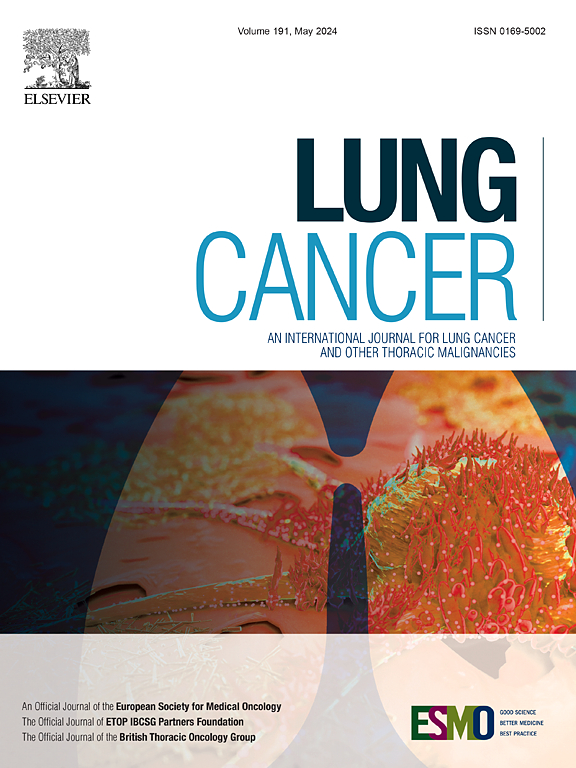释放潜力:组织突变丰度作为第三代EGFR-TKI在NSCLC疗效的预测因子
IF 4.4
2区 医学
Q1 ONCOLOGY
引用次数: 0
摘要
背景:第三代表皮生长因子受体(EGFR)酪氨酸激酶抑制剂(TKIs)被推荐作为具有EGFR敏感突变的不可切除的非小细胞肺癌(NSCLC)患者的一线治疗,但很少有研究探讨组织突变丰度在预测其疗效中的作用。为了优化靶向治疗,本研究比较了一线第三代EGFR-TKIs在不可切除的egfr敏感突变NSCLC患者中的疗效,重点关注组织突变丰度。方法回顾性分析697例患者的临床资料,最终纳入159例经筛查的患者。研究了两组治疗反应和中位无进展生存期(mPFS)的差异,并通过单因素和多因素分析确定了mPFS的危险因素。比较两组患者的疾病进展模式。结果两组患者的完全缓解率和部分缓解率无显著差异。然而,高丰度组的客观有效率(88%比66.7%,p = 0.032)和疾病控制率(97.2%比80.4%,p <;0.001)。高丰度组的mPFS也更长(22个月比17个月,p = 0.024)。在高丰度组中,突变位点、转移类型和共存的PI3KCA突变等因素在单因素分析中影响mPFS,而在多因素分析中没有影响。在低丰度组,ECOG PS和肿瘤部位影响mPFS。两组均表现出相似的疾病进展模式,包括原位肿瘤、内脏、骨和脑转移,但无统计学意义。结论在伴有egfr敏感突变的不可切除NSCLC中,组织突变丰度可预测第三代TKIs的疗效。高突变丰度的患者持续经历较长的mPFS。低丰度和周围性肺癌的mPFS也相对较长,但其他低丰度病例表现出快速的耐药性和进展。需要进一步的研究来为这些患者创造更精确、更个性化的治疗方法。本文章由计算机程序翻译,如有差异,请以英文原文为准。
Unlocking the potential: tissue mutation abundance as a predictor for third-generation EGFR-TKI efficacy in NSCLC
Background
Third-generation epidermal growth factor receptor (EGFR) tyrosine kinase inhibitors (TKIs) are recommended as first-line treatment for patients with unresectable non-small cell lung cancer (NSCLC) with EGFR-sensitive mutations, but few studies have explored the role of tissue mutation abundance in predicting their efficacy. To optimize targeted treatments, this study compares the efficacy of first-line third-generation EGFR-TKIs in unresectable NSCLC patients with EGFR-sensitive mutations, focusing on tissue mutation abundance.
Methods
The study retrospectively analyzed clinical data from 697 patients, ultimately including 159 after screening. Differences in treatment response and median progression-free survival (mPFS) between these groups were examined, and risk factors for mPFS were identified through univariate and multivariate analyses. The disease progression patterns of the two groups were also compared.
Results
There was no notable difference in complete and partial response rates between the groups. However, the high-abundance group had significantly higher objective response rate (88 % vs. 66.7 %, p = 0.032) and disease control rates (97.2 % vs. 80.4 %, p < 0.001). The mPFS was also longer in the high-abundance group (22 months vs. 17 months, p = 0.024). In the high-abundance group, factors like mutation site, metastasis types and co-existing PI3KCA mutations affected mPFS in univariate analysis, but not in multivariate analysis. In the low-abundance group, ECOG PS and tumor site influenced mPFS. Both groups showed similar patterns of disease progression, including in situ tumor, visceral, bone, and brain metastasis, without statistical significance.
Conclusions
In unresectable NSCLC with EGFR-sensitive mutations, tissue mutation abundance predicts the efficacy of third-generation TKIs. Patients with high mutation abundance consistently experience longer mPFS. Those with low abundance and peripheral lung cancer also have relatively long mPFS, but other low abundance cases show quick resistance and progression. Further research is needed to create more precise, personalized treatments for these patients.
求助全文
通过发布文献求助,成功后即可免费获取论文全文。
去求助
来源期刊

Lung Cancer
医学-呼吸系统
CiteScore
9.40
自引率
3.80%
发文量
407
审稿时长
25 days
期刊介绍:
Lung Cancer is an international publication covering the clinical, translational and basic science of malignancies of the lung and chest region.Original research articles, early reports, review articles, editorials and correspondence covering the prevention, epidemiology and etiology, basic biology, pathology, clinical assessment, surgery, chemotherapy, radiotherapy, combined treatment modalities, other treatment modalities and outcomes of lung cancer are welcome.
 求助内容:
求助内容: 应助结果提醒方式:
应助结果提醒方式:


